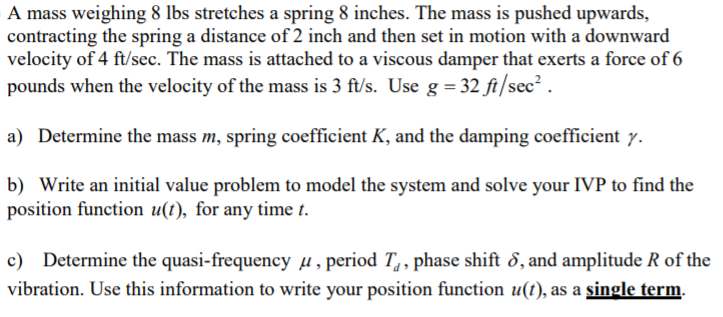A mass weighing 8 lbs stretches a spring 8 inches. The mass is pushed upwards, contracting the spring a distance of 2 inch and then set in motion with a downward velocity of 4 ft/sec. The mass is attached to a viscous damper that exerts a force of 6 pounds when the velocity of the mass is 3 ft/s. Use g = 32 ft/sec² . a) Determine the mass m, spring coefficient K, and the damping coefficient y. b) Write an initial value problem to model the system and solve your IVP to find the position function u(t), for any time t. c) Determine the quasi-frequency µ , period T,, phase shift 8, and amplitude R of the vibration. Use this information to write your position function u(t), as a single term.
Simple harmonic motion
Simple harmonic motion is a type of periodic motion in which an object undergoes oscillatory motion. The restoring force exerted by the object exhibiting SHM is proportional to the displacement from the equilibrium position. The force is directed towards the mean position. We see many examples of SHM around us, common ones are the motion of a pendulum, spring and vibration of strings in musical instruments, and so on.
Simple Pendulum
A simple pendulum comprises a heavy mass (called bob) attached to one end of the weightless and flexible string.
Oscillation
In Physics, oscillation means a repetitive motion that happens in a variation with respect to time. There is usually a central value, where the object would be at rest. Additionally, there are two or more positions between which the repetitive motion takes place. In mathematics, oscillations can also be described as vibrations. The most common examples of oscillation that is seen in daily lives include the alternating current (AC) or the motion of a moving pendulum.

Trending now
This is a popular solution!
Step by step
Solved in 4 steps with 5 images









